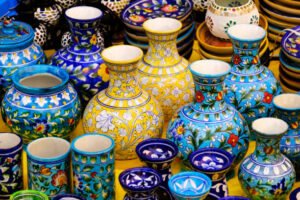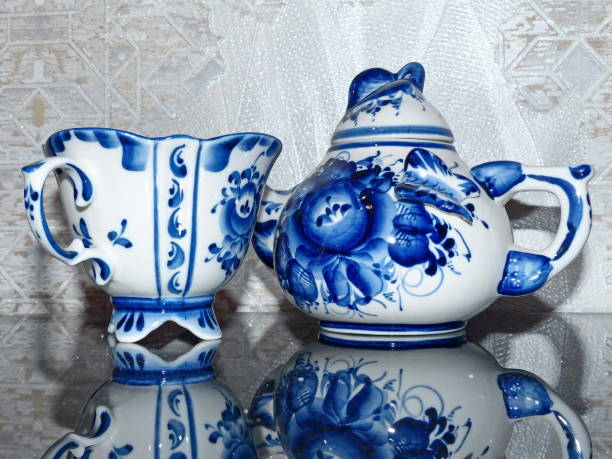Ginger jars, a symbol of heritage, are admired worldwide. These ancient Chinese ginger jars were used to store spices, particularly ginger, a coveted product in the spice trade. The ginger jar has grown from a practical container to a decorative artifact valued for its beauty and cultural importance.

Traditional ginger jars are earthenware with ornate decorations, a large body, and a domed cap. Chinese flower patterns, dragons, and folklore images are painted on porcelain bases in brilliant hues in these jars. These jars are hand-painted and glazed by skilled craftsmen who have perfected their trade over decades.
The Dutch East India Company brought ginger jars to Europe in the 17th century, making them popular in Western décor. The elite instantly adopted them, displaying them in their residences as emblems of wealth and sophistication. Ginger jars are still utilized in home design to combine Eastern and Western styles.
Ginger jars have collectors’ value beyond their historical and aesthetic significance. Antique ginger jars, which vary in value depending on age, condition, and rarity, are sought after by collectors and historians. Qing Dynasty jars are prized for their artistry and historical significance.
Modern ginger jars preserve their historical style while being updated. They come in many sizes and can be used as vases for flowers or as decorative pieces. Designers frequently arrange jars of different sizes and patterns to create attractive displays.
Ginger jars are now available in several hues and finishes to match any design style, from minimalistic to bohemian. Their versatility allows them to fit into shifting interior design trends, maintaining their popularity.
In addition, the ginger jar represents cultural fusion by showing how a common object in one culture can be reinterpreted and welcomed in another. Due to its cross-cultural appeal, each jar is a decorative object and a bearer of world stories and histories.
Ginger jars’ beauty and capacity to bridge East and West make them timeless. They remind us that decorative items formerly shaped daily life. By keeping such objects in our homes, we preserve craft traditions and cultural interactions.
The evolution of the ginger jar reminds us of our history’s global interconnection. Ginger jars’ history and beauty transcend decades and continents, whether on a mantelpiece, as a centerpiece, or as a gift.
Mastering Ginger Jar Maintenance: Tips and Techniques
Ginger jars’ rich history and beautiful styles have fascinated collectors and decorators worldwide. These delicate porcelain pieces need special care to stay beautiful. Ginger jars are cleaned to preserve their exquisite glaze and intricate painted patterns, which have been treasured for ages.
Ginger jars are art and history, so clean them with respect. Start by lightly dusting. Wipe the surface with a gentle, dry brush or microfiber cloth. It is essential to remove surface particles that could harm porcelain while washing thoroughly.
For deeper cleaning, use lukewarm water and mild soap. Avoid aggressive chemicals and abrasive cleaning that can damage glazing or fade colors. A delicate towel can be soaked in soapy water and wrung out until barely damp to wipe the jar carefully. Being gentle prevents rubbing that could damage the ornaments.
Immersing these costly things in water can weaken and destroy the porous porcelain, making rinsing the jar difficult. Instead of soaking, a clean, moist cloth washed in plain water can safely remove soap residue.
Cleaning and drying the ginger jar are equally crucial. Avoid air drying since moisture can damage the finish. Instead, gently pat the jar dry with a soft, dry towel. Pay special attention to crevices where water can hide.
Antique or rare ginger jars should be cleaned more carefully. In such circumstances, mild soap may be too abrasive. Dusting and a wet cloth without soap may work best here. Well-wrung cloth prevents extra water from touching porcelain.
Despite careful cleaning, ginger jars can develop tenacious stains. Baking soda and water paste might help with more challenging places. Apply the paste carefully with a soft cloth, let it remain for a few minutes, and then remove with a clean, damp towel. With caution, this mild abrasive can remove stains without hurting the surface.
Regular maintenance keeps ginger jars clean, although they sometimes need a deep clean. Consulting a professional is recommended, especially for antique or precious antiques. Professionals can customize cleaning services to the jar’s porcelain and painted embellishments to preserve its integrity.
The placement of ginger jars in the home can also affect cleaning frequency. Remove them from direct sunlight to prevent fading, and place them in a less trafficked area to reduce dust, bumps, and falls. Use stands or bases to protect the jars’ bottoms from scratches and grime.
Keeping track of each ginger jar’s condition and cleaning methods will help collectors establish a routine and determine the optimum methods for different materials and finishes.
Ginger jars require patience, sensitive handling, and a deep understanding of their cultural and historical significance to maintain their beauty. Through careful cleaning and regular maintenance, aficionados may preserve these exquisite relics for centuries.




Leave a Reply